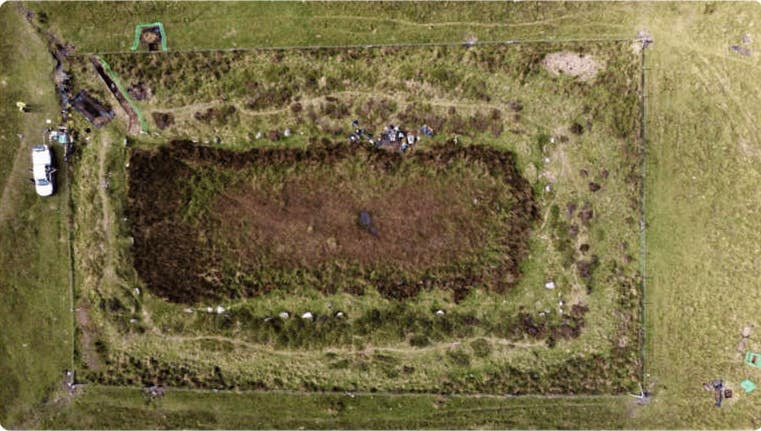Ancient King Arthur structure is five times older than previously thought
A site long steeped in the legend of King Arthur has been revealed to predate those myths by thousands of years.

The monument was previously listed as dating back to the medieval period but it is now believed to date back 4,000 years earlier to the Neolithic period. (CREDIT: Cornwall National Landscape)
A site long steeped in the legend of King Arthur has been revealed to predate those myths by thousands of years. King Arthur’s Hall, situated on Bodmin Moor in Cornwall, is now confirmed to date back to the Neolithic period, approximately 5,500 years ago.
This groundbreaking discovery, made possible through advanced archaeological techniques, significantly alters the historical narrative surrounding the site, shedding light on its importance within Cornwall’s prehistoric landscape.
Rewriting History
Previously thought to be a medieval structure, King Arthur’s Hall was often associated with utilitarian purposes, such as an animal pen or reservoir. However, new research has radically changed this perspective. Led by teams from the University of St Andrews, the University of Reading, and Newcastle University, the study revealed that the monument's origins extend far beyond the medieval era.
The structure, characterized by a rectangular enclosure formed by earth and stone banks and lined with 56 standing stones, has now been dated to the Neolithic period. This revelation emerged from a combination of radiocarbon dating and Optically Stimulated Luminescence (OSL).
OSL, a technique that determines when mineral grains were last exposed to sunlight, proved instrumental in this discovery. By examining soils buried beneath the monument's embankment, researchers concluded that its construction occurred between 5,000 and 5,500 years ago—predating prior estimates by roughly 4,000 years.
Dr. Tim Kinnaird, a geochronologist at the University of St Andrews, emphasized the importance of this breakthrough, describing it as a “major revelation.” He remarked, “This is extremely exciting. We’ve finally dated the construction of this enigmatic monument, which has been surrounded by myths and legends for centuries.”
This discovery not only redefines King Arthur’s Hall but also highlights the sophistication of Neolithic communities in constructing large, enduring monuments. It underscores the importance of revisiting historical assumptions with modern tools, allowing myths to give way to evidence-based understanding.
By uncovering the true age of King Arthur’s Hall, researchers have added a vital piece to the puzzle of Britain’s prehistoric heritage, connecting this mysterious structure to a much earlier chapter of human history.
Revisiting the Prehistoric Landscape
The discovery at King Arthur’s Hall suggests a thriving Neolithic community in Cornwall. Bodmin Moor, known for its wild, open landscape, features several other prehistoric sites, including standing stones, burial mounds, and tor enclosures like Rough Tor. These monuments indicate that the area was an important cultural and ceremonial hub thousands of years ago.
Related Stories
Dr. Rob Batchelor from the University of Reading emphasized the broader implications of the discovery: “The wild, remote landscape of Bodmin Moor has inspired legends for centuries, but this extraordinary finding shows how science can uncover stories that are just as intriguing.”
Further analysis of sediment cores could reveal more about the lives of the people who built and used these structures, shedding light on their environmental impact and societal organization.
James Gossip, representing the Cornwall Archaeological Unit (CAU), highlighted the significance of understanding the monument’s evolution. “This site was used and modified over millennia,” he explained. “Knowing when it was first built helps us better understand its original purpose and how its use changed over time.”
The rectangular layout of King Arthur’s Hall, combined with its standing stones, has puzzled archaeologists for years. Some speculate it may have served as a ceremonial site or even an enclosure for livestock.
Others propose it might have been a reservoir, collecting water in a landscape where resources were precious. “We’re still exploring whether the stones were placed during its initial construction or added later in prehistory,” Gossip added.
Legends Meet Science
The association with King Arthur is one of many romanticized links between Neolithic monuments and medieval mythology. Sites like Arthur’s Stone in Herefordshire and King Arthur’s Hall have been tied to the legendary king, even though they vastly predate the medieval era.
Historians generally agree that King Arthur, if he existed at all, would have lived in the fifth or sixth century AD, making it impossible for him to have had any connection to these ancient structures.
Despite this, Arthurian legends continue to shape public perceptions of sites like King Arthur’s Hall. Pete Herring, president of the Cornwall Archaeology Society, noted, “The 16th-century name ‘King Arthur’s Hall’ reflects a community’s effort to attribute ancient, mysterious sites to figures from folklore. It’s a testament to the enduring power of these legends.”
This blend of myth and history enriches the narrative surrounding Bodmin Moor. According to medieval Welsh texts, Bodmin Moor was the site of Arthur’s final battle against Mordred at Camlann. The battle, said to have taken place near the Cornish town of Camelford, adds to the region’s legendary status. However, the new findings firmly root King Arthur’s Hall in a much earlier era, long before the age of chivalry and knights.
Preserving the Past
While these revelations offer exciting new insights, they also highlight the challenges of preserving King Arthur’s Hall. The site is listed as “at risk” by Historic England due to overgrown vegetation and erosion caused by livestock and foot traffic. Archaeologists and conservationists urge visitors to tread carefully and respect the fragile nature of this ancient structure.
“The discovery makes it more important than ever to protect the site,” said Batchelor. “We need to ensure that future generations can continue to learn from and be inspired by this extraordinary monument.”
Cornwall National Landscape’s “A Monumental Improvement” project, which commissioned the archaeological investigations, aims to address these conservation challenges. The project seeks not only to protect King Arthur’s Hall but also to enhance public understanding of its significance within the prehistoric landscape.
A New Chapter for King Arthur’s Hall
The story of King Arthur’s Hall is far from over. As scientists delve deeper into the site’s sediments and standing stones, more secrets of Cornwall’s ancient past may come to light. This discovery invites a reimagining of Bodmin Moor’s role in prehistory, linking its monuments to a vibrant Neolithic culture.
In time, the site may reveal more about how early communities lived, celebrated, and connected with their environment. For now, the findings stand as a powerful reminder of how modern science can illuminate the distant past, offering fresh perspectives on even the most legendary of landscapes.
More about King Arthur
King Arthur, a legendary figure in British folklore, is renowned for his pivotal role in uniting Britain and establishing the utopian realm of Camelot. Though historical evidence of his existence is debated, his tale unfolds through a series of major milestones:
Mysterious Birth and Early Life
Arthur’s origins are steeped in myth and intrigue. According to most versions of the legend, he was the son of King Uther Pendragon and Igraine, the wife of Duke Gorlois of Cornwall. Uther, with the help of the wizard Merlin, used magical means to deceive Igraine and conceive Arthur.
To protect the child from Uther’s enemies, Merlin arranged for him to be raised in secret by Sir Ector, a loyal knight. Arthur grew up unaware of his royal heritage, receiving training in knightly skills alongside Ector’s son, Kay. This humble upbringing laid the foundation for his sense of justice and humility.
The Sword in the Stone
Arthur’s ascent to the throne is marked by a miraculous event. When King Uther died without an heir, the kingdom fell into disarray. Merlin orchestrated a test to identify the rightful king: a sword embedded in a stone, bearing the inscription that only the true king could remove it.
During a tournament, young Arthur, serving as Kay’s squire, inadvertently pulled the sword to replace a forgotten weapon. Witnesses recognized the act as divine proof of his legitimacy. This moment not only revealed Arthur’s royal lineage but also united the warring factions of Britain under his rule.
The Formation of the Round Table
Once crowned, Arthur sought to create a kingdom founded on equality, justice, and chivalry. He established the legendary Round Table, a large, circular table gifted by Guinevere’s father or, in some versions, crafted by Merlin. The table symbolized fairness, with no head or foot, placing all who sat there—Arthur and his knights—on equal footing.
Among these knights were iconic figures such as Sir Lancelot, Sir Gawain, Sir Percival, and Sir Galahad. The Round Table became a powerful emblem of unity and the pursuit of noble ideals.
Marriage to Guinevere
Arthur’s marriage to Guinevere was both a political alliance and a personal union. Guinevere, celebrated for her beauty and grace, became queen and a central figure in Camelot’s court. However, their marriage was fraught with challenges.
Her love affair with Sir Lancelot, Arthur’s closest knight, created a rift that weakened the cohesion of the Round Table. The scandal divided the knights and sowed discord, setting the stage for the eventual downfall of Arthur’s reign.
The Quest for the Holy Grail
One of the most spiritual and significant episodes in Arthurian legend is the quest for the Holy Grail. This sacred relic, believed to be the cup used by Christ at the Last Supper, was said to grant divine grace and eternal happiness. The quest symbolized the knights' spiritual and moral journey, testing their virtues of purity, courage, and faith.
Sir Galahad, known for his unmatched purity, was the only knight to achieve the Grail, highlighting the spiritual ideals that Arthur’s court aspired to, even as it faced internal struggles.
Conflict with Mordred
The seeds of Arthur’s downfall were sown through his complex relationship with Mordred. Depending on the version of the tale, Mordred is either Arthur’s illegitimate son (from an affair with his half-sister Morgause or Morgan le Fay) or his nephew.
Mordred harbored ambitions for the throne and exploited the kingdom’s internal divisions. In Arthur’s absence, Mordred seized power, declaring himself king and, in some accounts, attempting to marry Guinevere. Arthur’s return led to open conflict, culminating in the fateful Battle of Camlann.
Final Battle and Death
The Battle of Camlann marked the tragic end of Arthur’s reign. Accounts differ on the details, but the battle was fierce and devastating. Arthur and Mordred faced each other in combat, resulting in Mordred’s death and Arthur’s mortal wounding.
Fatally injured, Arthur was carried to the mystical Isle of Avalon by loyal followers, including Sir Bedivere. According to legend, Arthur did not die but instead rests in Avalon, awaiting a time when Britain will need him again. This notion of Arthur as a “once and future king” has cemented his place as a symbol of hope and unity in British lore.
These milestones define Arthur’s rise, reign, and tragic fall, encapsulating themes of heroism, betrayal, and the enduring quest for a just and noble society.
Note: Materials provided above by The Brighter Side of News. Content may be edited for style and length.
Like these kind of feel good stories? Get The Brighter Side of News' newsletter.
Rebecca Shavit
Science & Technology Journalist | Innovation Storyteller
Based in Los Angeles, Rebecca Shavit is a dedicated science and technology journalist who writes for The Brighter Side of News, an online publication committed to highlighting positive and transformative stories from around the world. With a passion for uncovering groundbreaking discoveries and innovations, she brings to light the scientific advancements shaping a better future. Her reporting spans a wide range of topics, from cutting-edge medical breakthroughs and artificial intelligence to green technology and space exploration. With a keen ability to translate complex concepts into engaging and accessible stories, she makes science and innovation relatable to a broad audience.



